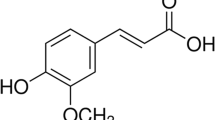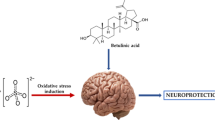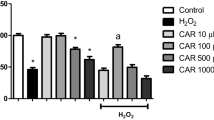Abstract
The therapeutic effect of phenolics on neurodegenerative diseases has been attributed to their potent antioxidant properties. In the present study, the neuroprotective activities of vanillin and vanillic acid were investigated in Fe2+- induced oxidative toxicity in brain tissues by investigating their therapeutic effects on oxidative imbalance, cholinergic and nucleotide-hydrolyzing enzymes activities, dysregulated metabolic pathways. Their cytotoxicity was investigated in hippocampal neuronal cell lines (HT22). The reduced glutathione level, SOD and catalase activities were ameliorated in tissues treated with the phenolics, with concomitant depletion of malondialdehyde and nitric oxide levels. They inhibited acetylcholinesterase and butyrylcholinesterase activities, while concomitantly elevated ATPase activity. Treatment with vanillin led to restoration of oxidative-depleted metabolites and reactivation of the pentose phosphate and purine metabolism pathways, with concomitant activation of pathways for histidine and selenoamino metabolisms. While vanillic acid restored and reactivated oxidative-depleted metabolites and pathways but did not activate any additional pathway. Both phenolics portrayed good binding affinity for catalase, with vanillic acid having the higher binding energy of −7.0 kcal/mol. Both phenolics were not cytotoxic on HT22 cells, and their toxicity class were predicted to be 4. Only vanillin was predicted to be permeable across the blood brain barrier (BBB). These results insinuate that vanillin and vanillic acid confer a neuroprotective effect on oxidative brain damage, when vanillin being the most potent.








Similar content being viewed by others
References
Adefegha SA, Oboh G, Oyeleye SI, Dada FA, Ejakpovi I, Boligon AA (2017) Cognitive enhancing and antioxidative potentials of velvet beans (mucuna pruriens) and horseradish (moringa oleifera) seeds extracts: a comparative study. J Food Biochem 41:e12292
Ademiluyi AO, Ogunsuyi OB, Oboh G (2016) Alkaloid extracts from jimson weed (Datura stramonium L.) modulate purinergic enzymes in rat brain. Neurotoxicol 56:107–117
Adewoye O, Bolarinwa A, Olorunsogo O (2000) Ca++, Mg++-ATPase activity in insulin-dependent and non-insulin dependent diabetic Nigerians. Afr J Med Med Sci 29:195–199
Akinyemi AJ, Onyebueke N, Faboya OA, Onikanni SA, Fadaka A, Olayide I (2017) Curcumin inhibits adenosine deaminase and arginase activities in cadmium-induced renal toxicity in rat kidney. J Food Drug Anal 25:438–446
Akomolafe S, Akinyemi A, Ogunsuyi O, Oyeleye S, Oboh G, Adeoyo O, Allismith Y (2017) Effect of caffeine, caffeic acid and their various combinations on enzymes of cholinergic, monoaminergic and purinergic systems critical to neurodegeneration in rat brain—in vitro. NeuroToxicol 62:6–13
Banerjee P, Eckert AO, Schrey AK, Preissner R (2018) ProTox-II: a webserver for the prediction of toxicity of chemicals. Nucleic Acids Res 46:W257–W263
Bastianetto S, Yao ZX, Papadopoulos V, Quirion R (2006) Neuroprotective effects of green and black teas and their catechin gallate esters against β-amyloid-induced toxicity. Eur J Neurosci 23:55–64
Belaidi AA, Bush AI (2016) Iron neurochemistry in Alzheimer’s disease and Parkinson’s disease: targets for therapeutics. J Neurochem 139:179–197
Bezerra DP, Soares AKN, de Sousa DP (2016) Overview of the role of vanillin on redox status and cancer development. Oxidative Med Cell Longev 2016:9734816
Butterfield DA, Drake J, Pocernich C, Castegna A (2001) Evidence of oxidative damage in Alzheimer’s disease brain: central role for amyloid β-peptide. Trends Mol Med 7:548–554
Calixto-Campos C et al (2015) Vanillic acid inhibits inflammatory pain by inhibiting neutrophil recruitment, oxidative stress, cytokine production, and NFκB activation in mice. J Nat Prod 78:1799–1808
Chan CXA, Khan AA, Choi JH, Ng CD, Cadeiras M, Deng M, Ping P (2013) Technology platform development for targeted plasma metabolites in human heart failure. Clin Proteomics 10:7
Chance B, Maehly A (1955) Assay of catalases and peroxidases. Methods Enzymol 2:764–775
Chong J et al (2018) MetaboAnalyst 4.0: towards more transparent and integrative metabolomics analysis. Nucleic Acid Res 46:W486–W494
Chowdhury P, Soulsby M (2002) Lipid peroxidation in rat brain is increased by simulated weightlessness and decreased by a soy-protein diet. Ann Clin Lab Sci 32:188–192
Cobley JN, Fiorello ML, Bailey DM (2018) 13 reasons why the brain is susceptible to oxidative stress. Redox Biol 15:490–503
Ćupić Miladinović D, Borozan S, Ivanović S (2018) Involvement of cholinesterases in oxidative stress induced by chlorpyrifos in the brain of Japanese quail. Poultry Sci 97:1564–1571
Daina A, Michielin O, Zoete V (2017) SwissADME: a free web tool to evaluate pharmacokinetics, drug-likeness and medicinal chemistry friendliness of small molecules. Sci Report 7:42717
Deng P, Barney J, Petriello MC, Morris AJ, Wahlang B, Hennig B (2019) Hepatic metabolomics reveals that liver injury increases PCB 126-induced oxidative stress and metabolic dysfunction. Chemosphere 217:140–149
Dhanalakshmi C, Manivasagam T, Nataraj J, Justin Thenmozhi A, Essa MM (2015) Neurosupportive role of vanillin, a natural phenolic compound, on rotenone induced neurotoxicity in SH-SY5Y neuroblastoma cells. Evid Based Complement Alternat Med 2015:626028
Dhanalakshmi C, Janakiraman U, Manivasagam T, Justin Thenmozhi A, Essa MM, Kalandar A, Khan MA, Guillemin GJ (2016) Vanillin attenuated behavioural impairments, neurochemical deficts, oxidative stress and apoptosis against rotenone induced rat model of Parkinson’s disease. Neurochem Res 41:1899–1910
Drwal MN, Banerjee P, Dunkel M, Wettig MR, Preissner R (2014) ProTox: a web server for the in silico prediction of rodent oral toxicity. Nucleic Acid Res 42:W53–W58
Ellman GL (1959) Tissue sulfhydryl groups. Arch Biochem Biophys 82:70–77
Ellman GL, Courtney KD, Andres V Jr, Featherstone RM (1961) A new and rapid colorimetric determination of acetylcholinesterase activity. Biochem Pharmacol 7:88–95
Erukainure OL, Mopuri R, Oyebode OA, Koorbanally NA, Islam MS (2017a) Dacryodes edulis enhances antioxidant activities, suppresses DNA fragmentation in oxidative pancreatic and hepatic injuries; and inhibits carbohydrate digestive enzymes linked to type 2 diabetes. Biomed Pharmacother 96:37–47
Erukainure OL, Oyebode OA, Sokhela MK, Koorbanally NA, Islam MS (2017b) Caffeine–rich infusion from Cola nitida (kola nut) inhibits major carbohydrate catabolic enzymes; abates redox imbalance; and modulates oxidative dysregulated metabolic pathways and metabolites in Fe 2+−induced hepatic toxicity. Biomed Pharmacother 96:1065–1074
Erukainure OL, Sanni O, Islam MS (2018) Clerodendrum volubile: phenolics and applications to health. In: Watson R, Preedy V, Zibadi S (eds) Polyphenols: mechanisms of action in human health and disease, 2nd edn. Elsevier. https://doi.org/10.1016/B978-0-12-813006-3.00006-4
Erukainure OL, Oyebode OA, Ibeji CU, Koorbanally NA, Islam MS (2019) Vernonia Amygdalina Del. stimulated glucose uptake in brain tissues enhances antioxidative activities; and modulates functional chemistry and dysregulated metabolic pathways. Metab Brain Dis. https://doi.org/10.1007/s11011-018-0363-7
Grantham-McGregor S, Ani C (2001) A review of studies on the effect of iron deficiency on cognitive development in children. J Nutr 131:649S–668S
Greig NH, Lahiri DK, Sambamurti K (2002) Butyrylcholinesterase: an important new target in Alzheimer's disease therapy. Int Psychogeriatr 14:77–91
Haas HL, Sergeeva OA, Selbach O (2008) Histamine in the nervous system. Physiol Rev 88:1183–1241
Hasegawa H, Oguro K, Naito Y, Ichiyama A (1999) Iron dependence of tryptophan hydroxylase activity in RBL2H3 cells and its manipulation by chelators. Eur J Biochem 261:734–739
Hidalgo C, Núñez MT (2007) Calcium, iron and neuronal function. IUBMB Life 59:280–285
Huang X, Moir RD, Tanzi RE, Bush AI, Rogers JT (2004) Redox-active metals, oxidative stress, and Alzheimer’s disease pathology. Ann N Y Acad Sci 1012:153–163
Kakkar P, Das B, Viswanathan P (1984) A modified spectrophotometric assay of superoxide dismutase. Indian J Biochem Biophys 21:130–132
Kim GH, Kim JE, Rhie SJ, Yoon S (2015) The role of oxidative stress in neurodegenerative diseases. Exp Neurobiol 24:325–340
Kumar S, Prahalathan P, Raja B (2011) Antihypertensive and antioxidant potential of vanillic acid, a phenolic compound in L-NAME-induced hypertensive rats: a dose-dependence study. Redox Rep 16:208–215
Kumar R, Sharma P, Mishra P (2012) A review on the vanillin derivatives showing various biological activities. Int J PharmTech Res 4:266–279
Latunde-Dada GO (2017) Ferroptosis: role of lipid peroxidation, iron and ferritinophagy. Biochim Biophys Acta (BBA)-Gen Subj 1861:1893–1900
Li D (1998) Effects of iron deficiency on iron distribution and gamma-aminobutyric acid (GABA) metabolism in young rat brain tissues. Hokk J Med Sci 73:215–225
Maya S, Prakash T, Madhu KD, Goli D (2016) Multifaceted effects of aluminium in neurodegenerative diseases: a review. Biomed Pharmacother 83:746–754
Mehan S, Kaur G, Dudi R, Rajput M, Kalra S (2017) Restoration of mitochondrial dysfunction in 6-hydroxydopamine induced Parkinson’s disease: a complete review. Open J Park Dis Treat 1:1–26
Melo JB, Agostinho P, Oliveira CR (2003) Involvement of oxidative stress in the enhancement of acetylcholinesterase activity induced by amyloid beta-peptide. Neurosci Res 45:117–127
Mosmann T (1983) Rapid colorimetric assay for cellular growth and survival: application to proliferation and cytotoxicity assays. J Immunol Methods 65:55–63
Niedzielska E, Smaga I, Gawlik M, Moniczewski A, Stankowicz P, Pera J, Filip M (2016) Oxidative stress in neurodegenerative diseases. Mol Neurobiol 53:4094–4125
Oyebode OA, Erukainure OL, Chukwuma CI, Ibeji CU, Koorbanally NA, Islam S (2018) Boerhaavia diffusa inhibits key enzymes linked to type 2 diabetes in vitro and in silico; and modulates abdominal glucose absorption and muscle glucose uptake ex vivo. Biomed Pharmacother 106:1116–1125
Patel M (2016) Targeting oxidative stress in central nervous system disorders. Trends Pharmacol Sci 37:768–778
Salau VF, Erukainure OL, Ibeji CU, Olasehinde TA, Koorbanally NA, Islam MS (2019) Ferulic acid modulates dysfunctional metabolic pathways and purinergic activities, while stalling redox imbalance and cholinergic activities in oxidative brain injury. Neurotox Res:1–12. https://doi.org/10.1007/s12640-019-00099-7
Sanni O, Erukainure OL, Chukwuma CI, Koorbanally NA, Ibeji CU, Islam MS (2019) Azadirachta indica inhibits key enzyme linked to type 2 diabetes in vitro, abates oxidative hepatic injury and enhances muscle glucose uptake ex vivo. Biomed Pharmacother 109:734–743
Schrauzer GN (2000) Selenomethionine: a review of its nutritional significance, metabolism and toxicity. J Nutr 130:1653–1656
Soobrattee MA, Neergheen VS, Luximon-Ramma A, Aruoma OI, Bahorun T (2005) Phenolics as potential antioxidant therapeutic agents: mechanism and actions. Mutat Res/Fund Mol Mech Mutagen 579:200–213
Szwajgier D, Borowiec K, Pustelniak K (2017) The neuroprotective effects of phenolic acids: molecular mechanism of action. Nutrients 9:477
Tsikas D (2005) Review methods of quantitative analysis of the nitric oxide metabolites nitrite and nitrate in human biological fluids. Free Radic Res 39:797–815
Tsuda H et al (1994) Chemopreventive effects of β-carotene, α-tocopherol and five naturally occurring antioxidants on initiation of Hepatocarcinogenesis by 2-Amino-3-methylimidazo [4, 5-f] qumoline in the rat. Jpn J Cancer Res 85:1214–1219
Williams A, Ford W (2004) Functional significance of the pentose phosphate pathway and glutathione reductase in the antioxidant defenses of human sperm. Biol Reprod 71:1309–1316
Wishart DS et al (2012) HMDB 3.0—the human metabolome database in 2013. Nucleic Acids Res 41:D801–D807
Yoshikawa T et al (2014) Insufficient intake of L-histidine reduces brain histamine and causes anxiety-like behaviors in male mice. J Nutr 144:1637–1641
Acknowledgements
This work was supported by funding from the Research office, University of KwaZulu-Natal, Durban and the National Research Foundation- the World Academy of Science (NRF-TWAS), Pretoria, South Africa.
Author information
Authors and Affiliations
Corresponding author
Ethics declarations
Conflict of interest
The authors declare that they have no conflicts of interest relating to this work.
Additional information
Publisher’s note
Springer Nature remains neutral with regard to jurisdictional claims in published maps and institutional affiliations.
Rights and permissions
About this article
Cite this article
Salau, V.F., Erukainure, O.L., Ibeji, C.U. et al. Vanillin and vanillic acid modulate antioxidant defense system via amelioration of metabolic complications linked to Fe2+-induced brain tissues damage. Metab Brain Dis 35, 727–738 (2020). https://doi.org/10.1007/s11011-020-00545-y
Received:
Accepted:
Published:
Issue Date:
DOI: https://doi.org/10.1007/s11011-020-00545-y




